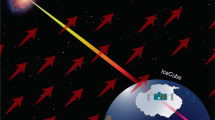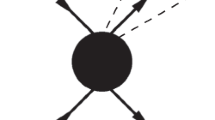Abstract
The neutrino theory of light proposed by Jordan1 postulates a connexion between the quantized wave function of the light field (F) and that of the neutrino-field (). Since satisfies the commutation rules for Fermi statistics and F those of the Bose statistics, the connexion cannot be a linear one. On the other hand, we know from quantum electrodynamics that F satisfies a linear differential equation; a similar-equation of d'Alembert's type is to be expected for . Thus a contradiction arises between the linearity of the equations and the non-linearity of the connexion between F and . (This contradiction is avoided only in the case of plane waves propagating in one definite direction.) Besides, serious doubts arise as to the possibility of expressing the quantized amplitudes b() for F (Bose statistics) in terms of the-amplitudes () for (Fermi statistics), the operators b() and () being of a quite different mathematical nature.
This is a preview of subscription content, access via your institution
Access options
Subscribe to this journal
Receive 51 print issues and online access
$199.00 per year
only $3.90 per issue
Buy this article
- Purchase on Springer Link
- Instant access to full article PDF
Prices may be subject to local taxes which are calculated during checkout
Similar content being viewed by others
References
Z. Phys., 93, 464 (1935).
P. Jordan, ” Anschauliche Quantentheorie” (Berlin: Springer, 1936), p. 269.
Author information
Authors and Affiliations
Rights and permissions
About this article
Cite this article
FOCK, V. Inconsistency of the Neutrino Theory of Light. Nature 138, 1011–1012 (1936). https://doi.org/10.1038/1381011b0
Published:
Issue Date:
DOI: https://doi.org/10.1038/1381011b0
This article is cited by
-
The Luttinger model
Journal of Statistical Physics (1980)
-
Neutrino Theory of Light
Nature (1937)
-
Neutrino Theory of Light
Nature (1937)
Comments
By submitting a comment you agree to abide by our Terms and Community Guidelines. If you find something abusive or that does not comply with our terms or guidelines please flag it as inappropriate.



